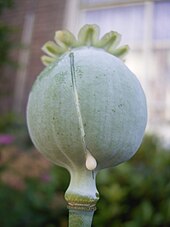Latex
[2] It is a complex emulsion that coagulates on exposure to air, consisting of proteins, alkaloids, starches, sugars, oils, tannins, resins, and gums.
Since the 17th century, latex has been used as a term for the fluid substance in plants, deriving from the Latin word for "liquid".
[6] The cells (laticifers) in which latex is found make up the laticiferous system, which can form in two very different ways.
The laticiferous system is present in all parts of the mature plant, including roots, stems, leaves, and sometimes the fruits.
The idea was first proposed in 1887 by Joseph F. James, who noted that latex of milkweed carries with it at the same time such disagreeable properties that it becomes a better protection to the plant from enemies than all the thorns, prickles, or hairs that could be provided.
"[10] The clotting property of latex is functional in this defense since it limits wastage and its stickiness traps insects and their mouthparts.
[12] This latex is used to make many other products including mattresses,[13] gloves, swim caps, condoms, catheters and balloons.
[citation needed] Dried latex from the opium poppy is called opium, the source of several useful analgesic alkaloids such as codeine, thebaine, and morphine, the latter two of which can then further be used in the synthesis and manufacture of other (typically stronger) opioids for medicinal use, and of heroin for the illegal drug trade.
[14] Synthetic latices are used in coatings (e.g., latex paint) and glues because they solidify by coalescence of the polymer particles as the water evaporates.
[15] Some people only experience a mild allergy when exposed to latex, with symptoms such as eczema, contact dermatitis, or developing a rash.
[19] In a 2024 comprehensive review by Gromek et al., the last 30 years of research on LFS were summarized, focusing on its prevalence, common cross-reactions, and clinical manifestations.
The review found that the prevalence of LFS in latex-allergic patients varies widely, ranging from 4% to 88%, depending on diagnostic methods, geographical regions, and study populations.
Gromek et al. also highlighted the need for standardized diagnostic criteria and severity grading systems to improve the accuracy of LFS diagnosis and treatment.
[20] Several species of the microbe genera Actinomycetes, Streptomyces, Nocardia, Micromonospora, and Actinoplanes are capable of consuming rubber latex.


